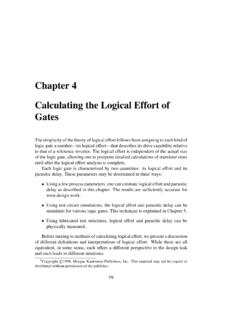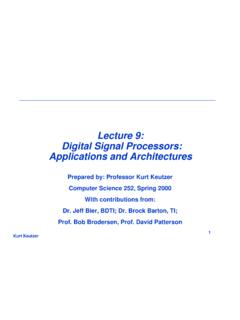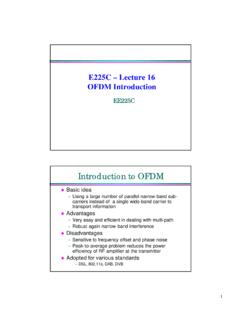Transcription of DESIGNING COMBINATIONAL LOGIC GATES IN CMOS
1 CHAPTER. 6. DESIGNING COMBINATIONAL . LOGIC GATES IN cmos . In-depth discussion of LOGIC families in cmos static and dynamic, pass-transistor, nonra- tioed and ratioed LOGIC n Optimizing a LOGIC gate for area, speed, energy, or robustness n Low-power and high-performance circuit-design techniques Introduction Speed and Power Dissipation of Dynamic LOGIC Static cmos Design Issues in Dynamic Design Complementary cmos . Cascading Dynamic GATES Leakage in Low Voltage Systems Ratioed LOGIC Perspective: How to Choose a LOGIC Style Pass-Transistor LOGIC Summary Dynamic cmos Design To Probe Further Dynamic LOGIC : Basic Principles Exercises and Design Problems 197. 198 DESIGNING COMBINATIONAL LOGIC GATES IN cmos Chapter 6. Introduction The design considerations for a simple inverter circuit were presented in the previous chapter. In this chapter, the design of the inverter will be extended to address the synthesis of arbitrary digital GATES such as NOR, NAND and XOR. The focus will be on combina- tional LOGIC (or non-regenerative) circuits that have the property that at any point in time, the output of the circuit is related to its current input signals by some Boolean expression (assuming that the transients through the LOGIC GATES have settled).
2 No intentional connec- tion between outputs and inputs is present. In another class of circuits, known as sequential or regenerative circuits to be dis- cussed in a later chapter , the output is not only a function of the current input data, but also of previous values of the input signals (Figure ). This is accomplished by connect- ing one or more outputs intentionally back to some inputs. Consequently, the circuit remembers past events and has a sense of history. A sequential circuit includes a combi- national LOGIC portion and a module that holds the state. Example circuits are registers, counters, oscillators, and memory. COMBINATIONAL In COMBINATIONAL Out In LOGIC Out LOGIC Circuit Circuit State (a) COMBINATIONAL (b) Sequential Figure High level classification of LOGIC circuits. There are numerous circuit styles to implement a given LOGIC function. As with the inverter, the common design metrics by which a gate is evaluated include area, speed, energy and power.
3 Depending on the application, the emphasis will be on different metrics ( , in high performance processor, the switching speed of digital circuits is the primary metric while in a battery operated circuit it is the energy dissipation). In addition to these metrics, robustness to noise is also a very important consideration. We will see that certain LOGIC styles ( , Dynamic LOGIC ) can significantly improve performance, but can be more sensitive to noise. Recently, power dissipation has also become a very important require- ment and significant emphasis is placed on understanding the sources of power and approaches to deal with power. Static cmos Design The most widely used LOGIC style is static complementary cmos . The static cmos style is really an extension of the static cmos inverter to multiple inputs. In review, the pri- mary advantage of the cmos structure is robustness ( , low sensitivity to noise), good performance, and low power consumption (with no static power consumption).
4 As we will Section Static cmos Design 199. see, most of those properties are carried over to large fan-in LOGIC GATES implemented using the same circuit topology. The complementary cmos circuit style falls under a broad class of LOGIC circuits called static circuits in which at every point in time (except during the switching tran- sients), each gate output is connected to either VDD or Vss via a low-resistance path. Also, the outputs of the GATES assume at all times the value of the Boolean function implemented by the circuit (ignoring, once again, the transient effects during switching periods). This is in contrast to the dynamic circuit class, that relies on temporary storage of signal values on the capacitance of high-impedance circuit nodes. The latter approach has the advantage that the resulting gate is simpler and faster. On the other hand, its design and operation are more involved than those of its static counterpart, due to an increased sensitivity to noise.
5 In this section, we sequentially address the design of various static circuit flavors including complementary cmos , ratioed LOGIC (pseudo-NMOS and DCVSL), and pass- transistor LOGIC . The issues of scaling to lower power supply voltages and threshold volt- ages will also be dealt with. Complementary cmos . A static cmos gate is a combination of two networks, called the pull-up network (PUN). and the pull-down network (PDN) (Figure ). The figure shows a generic N input LOGIC gate where all inputs are distributed to both the pull-up and pull-down networks. The func- tion of the PUN is to provide a connection between the output and VDD anytime the output of the LOGIC gate is meant to be 1 (based on the inputs). Similarly, the function of the PDN. is to connect the output to VSS when the output of the LOGIC gate is meant to be 0. The PUN. and PDN networks are constructed in a mutually exclusive fashion such that one and only one of the networks is conducting in steady state.
6 In this way, once the transients have set- tled, a path always exists between VDD and the output F, realizing a high output ( one ), or, alternatively, between VSS and F for a low output ( zero ). This is equivalent to stating that the output node is always a low-impedance node in steady state. In constructing the PDN and PUN networks, the following observations should be kept in mind: VDD. In1. In2 pull-up: make a connection from VDD to F when PUN. F(In1,In2, .. Inn) = 1. InN. F (In1,In2, .. Inn). In1. In2. pull-down: make a connection from VDD to Vss when PDN F(In1,In2, .. Inn) = 0. InN. VSS. Figure Complementary LOGIC gate as a combination of a PUN (pull-up network) and a PDN (pull-down network). 200 DESIGNING COMBINATIONAL LOGIC GATES IN cmos Chapter 6. A transistor can be thought of as a switch controlled by its gate signal. An NMOS. switch is on when the controlling signal is high and is off when the controlling signal is low. A PMOS transistor acts as an inverse switch that is on when the controlling signal is low and off when the controlling signal is high.
7 The PDN is constructed using NMOS devices, while PMOS transistors are used in the PUN. The primary reason for this choice is that NMOS transistors produce strong zeros, and PMOS devices generate strong ones . To illustrate this, con- sider the examples shown in Figure In Figure , the output capacitance is ini- tially charged to VDD. Two possible discharge scenario's are shown. An NMOS. device pulls the output all the way down to GND, while a PMOS lowers the output no further than |VTp| the PMOS turns off at that point, and stops contributing dis- charge current. NMOS transistors are hence the preferred devices in the PDN. Simi- larly, two alternative approaches to charging up a capacitor are shown in Figure , with the output load initially at GND. A PMOS switch succeeds in charging the output all the way to VDD, while the NMOS device fails to raise the output above VDD-VTn. This explains why PMOS transistors are preferentially used in a PUN. Out VDD 0 Out VDD |VTp|.
8 VDD CL CL. (a) pulling down a node using NMOS and PMOS switches VDD 0 VDD- VTn 0 VDD. Out Out CL. CL. (b) pulling down a node using NMOS and PMOS switches Figure Simple examples illustrate why an NMOS should be used as a pull- down transistor, while a PMOS should be used as a pull-up device. A set of construction rules can be derived to construct LOGIC functions (Figure ). NMOS devices connected in series corresponds to an AND function. With all the inputs high, the series combination conducts and the value at one end of the chain is transfered to the other end. Similarly, NMOS transistors connected in parallel repre- sent an OR function. A conducting path exists between the output and input terminal if at least one of the inpurs is high. Using similar arguments, construction rules for PMOS networks can be formulated. A series connection of PMOS conducts if both Section Static cmos Design 201. B A. Series Combination Parallel Combination A B. Conducts if A B Conducts if A + B.
9 (a) series (b) parallel Figure NMOS LOGIC rules series devices implement an AND, and parallel devices implement an OR. inputs are low, representing a NOR function ( = A+B), while PMOS transistors in parallel implement a NAND (A+B = A B. Using De Morgan's theorems ((A + B) = A B and A B = A + B), it can be shown that the pull-up and pull-down networks of a complementary cmos structure are dual networks. This means that a parallel connection of transistors in the pull-up network corresponds to a series connection of the corresponding devices in the pull-down network, and vice versa. Therefore, to construct a cmos gate, one of the networks ( , PDN) is implemented using combinations of series and parallel devices. The other network ( , PUN) is obtained using duality principle by walking the hierar- chy, replacing series subnets with parallel subnets, and parallel subnets with series subnets. The complete cmos gate is constructed by combining the PDN with the PUN.)
10 The complementary gate is naturally inverting, implementing only functions such as NAND, NOR, and XNOR. The realization of a non-inverting Boolean function (such as AND OR, or XOR) in a single stage is not possible, and requires the addi- tion of an extra inverter stage. The number of transistors required to implement an N-input LOGIC gate is 2N. Example Two input NAND Gate Figure shows a two-input NAND gate (F = A B). The PDN network consists of two NMOS devices in series that conduct when both A and B are high. The PUN is the dual net- work, and consists of two parallel PMOS transistors. This means that F is 1 if A = 0 or B = 0, which is equivalent to F = A B. The truth table for the simple two input NAND gate is given in Table It can be verified that the output F is always connected to either VDD or GND, but never to both at the same time. Example Synthesis of complex cmos Gate Using complementary cmos LOGIC , consider the synthesis of a complex cmos gate whose function is F = D + A (B +C).












